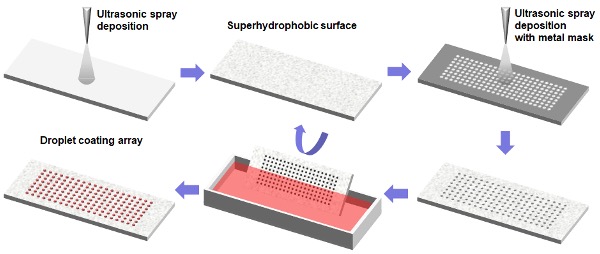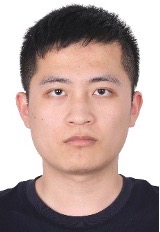A High-throughput Droplet Microarray
Based on Spray Coating Technology
Cong Wang, Yunfan Xue, Junjie Huang, Kefeng
Ren*, Jian Ji*
MOE Key Laboratory of
Macromolecule Synthesis and Functionalization, Department of Polymer Science and Engineering, Zhejiang
University, Hangzhou 310027, China.
ABSTRACT: Droplet microarray
featuring high integration and miniaturization is an important high-throughput
screening technology which can effectively reduce the reagent consumption.
However, it usually demands superhydrophobic-superhydrophilic wettability
contrast and suffers from complicated fabrication process and limited options
of substrate materials. Herein we suppose a facile method to fabricate droplet
microarrays for high-throughput screening through spray coating and explore the
feasibility of a variety of materials for the preparation of such droplet
microarrays. First, Polydimethylsiloxane and polymethyl methacrylate (PMMA)
were deposited onto a PMMA slide via ultrasonic spraying to obtain a
superhydrophobic surface. Then, with the help of the mask, the coating arrays
of poly(lactic-co-glycolic acid) (PLGA) and poly (limonene carbonate) (PLimC)
were prepared respectively. We then sprayed DCM as swelling agent to smooth the
rough surface and found the hydrophobicity of both materials was decreased. We
proved that the smoothed materials were able to introduce wettability contrast
with superhydrophobic background. Due to the relative “hydrophilicity” of PLGA,
the as-prepared coating array could form droplet microarray by dragging a large
droplet through the entire surface via discontinuous dewetting. Four common
substrates used in cell culture which were polystyrene, thermoplastic
polyurethanes, polycaprolactone and poly (L-lactic acid) were used to prepare
drop microarrays in view of their hydrophilicity. In order to validate that the
as-prepared droplet microarrays were suitable for the high-throughput cellular
experiments, we cultured human umbilical vein endothelial cells (ECs) on
coating arrays of PLGA with RGD. The results showed that ECs spread well and
cell numbers were uniformly located which demonstrated the potential of
ultrasonic spray coating technology for fabrication of droplet microarray and
high-throughput screening of cells.

Keywords: droplet microarray; ultrasonic spraying; high-throughput screening

Cong Wang received his B.E. degree from Zhejiang University and has been a Ph.D student in Department of Polymer Science and Engineering under the supervision of Prof. Jian Ji since 2019. He is interested in developing high-throughput screening platforms. Reporter’s Email: 3150102740@zju.edu.cn